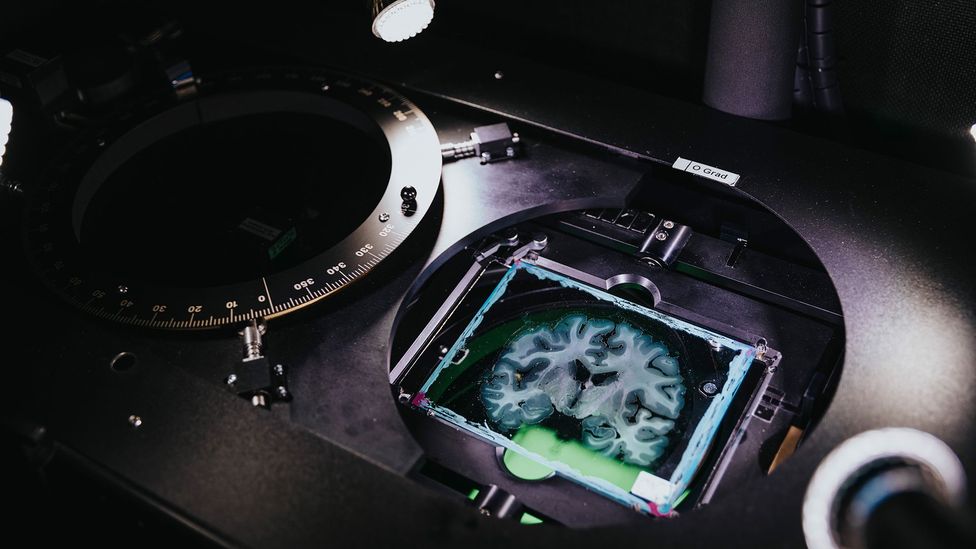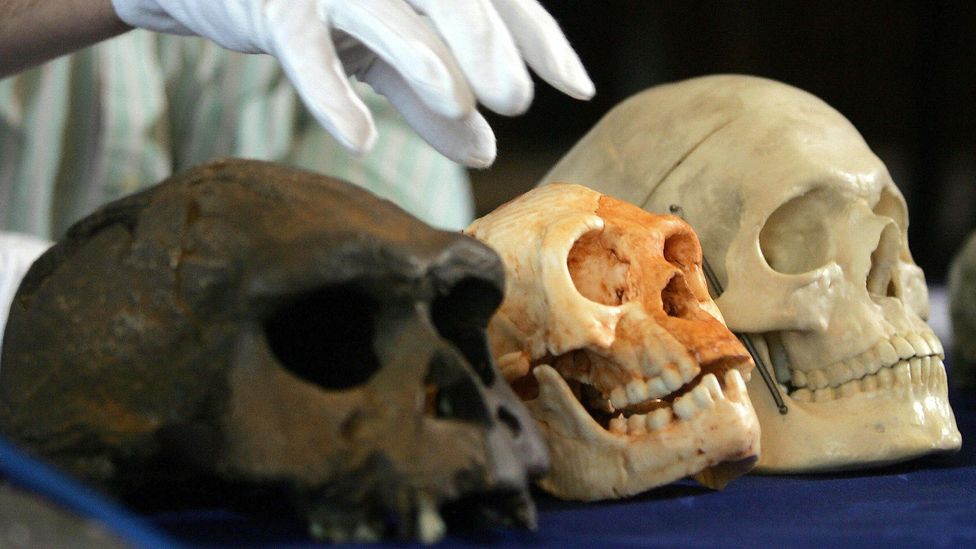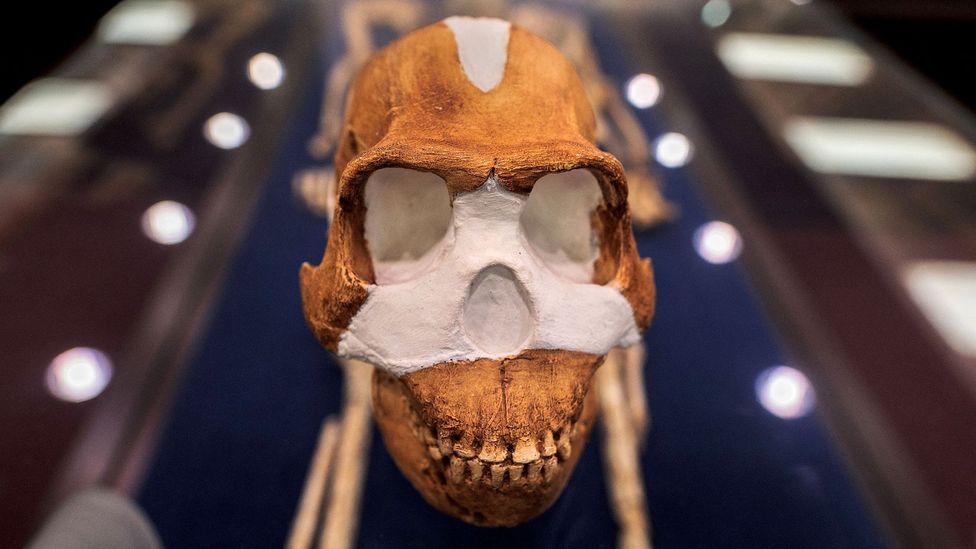
Human brains are bigger than those of our primate relatives, but evidence from extinct human ancestors suggests size isn’t everything. To understand human intelligence, scientists are now looking deeper
Arthur Keith was one of those misbegotten researchers who have turned out to be wrong in many of the things they said. A prominent anatomist and anthropologist in the early 20th Century, he was a proponent of scientific racism and opposed racial mixing. At least partly because of his racial views, he was convinced humans originated in Europe, not Africa as is now universally accepted. And he was a strong supporter of Piltdown Man, a notorious hoax involving fake fossils.
Keith also described a notion that became known as the cerebral Rubicon. Noting that humans have larger brains than other primates, he argued that human intelligence only became possible once our brains reached a particular threshold size. For Homo, the genus to which we belong, he thought the minimum volume was around 600-750 cubic cm (37-46 cubic inches). For our species Homo sapiens, it was 900 cubic cm (55 cubic inches). Any smaller, the argument went, and the brain wouldn’t have enough computational power to support human reasoning.
It’s certainly true that Homo sapiens, as a species, have large brains. But what this means is increasingly murky. Evidence from palaeoanthropology suggests that some species, such as the “hobbits” Homo floresiensis and Homo naledi, performed complex behaviours despite having fairly small brains. These reports are contentious. However, there is also gathering evidence from genetics and neuroscience that brain size is far from the be-all-and-end-all of intelligence.
Instead, changes to the brain’s wiring diagram, to the shapes of neurons, and even to when and where certain genes are turned on, are all equally if not more important. Size, as we might have guessed, isn’t everything.
Small-brained smarts
It’s certainly true that the human brain is unusually large. This remains true even if you look at brain size relative to the size of our bodies. “Humans are by far the primates with the largest brain,” says neuroscientist Martijn van den Heuvel of the Free University Amsterdam in the Netherlands.
It’s also true that if you look at the last six million years of human evolution, there is a trend towards increasing brain size. Early hominins like Sahelanthropus and Australopithecus have relatively small brains, but the first Homo species have bigger ones, and Homo sapiens brains are bigger still.
However, when you look more closely at the details, the story isn’t so simple. Two species stand out for their unusually small brains: Homo floresiensis, also known as the real-life “hobbit”, and Homo naledi. Both are 21st-Century discoveries.
Homo floresiensis had a skull about the size of a grapefruit and has challenged many preconceptions about how human brain size relates to intelligence
H. floresiensis was first described in 2004. They were just 1m (3ft) tall and lived on the island of Flores in Indonesia within the last few hundred thousand years. They died out at least 50,000 years ago. The first specimen had a brain measuring just 380 cubic cm (23 cubic inches) or perhaps 426 cubic cm (26 cubic inches), putting her on a par with chimpanzees.
There is solid evidence that H. floresiensis made and used stone tools, much as other Homo species did. Early studies also reported evidence of burning, suggesting the hobbits had control of fire. However, later re-analyses suggested the fires were all lit more recently than 41,000 years ago – suggesting they were made by modern humans, not the hobbits. Nevertheless, the stone tools alone are evidence that hobbits behaved in ways that chimpanzees cannot.
A decade later, researchers in South Africa described Homo naledi. The remains were found deep in the Rising Star cave system, which only experienced cavers can reach. Like the hobbits, H. naledi had small brains – but they also lived recently, between 200,000 and 300,000 years ago.
Lead researcher Lee Berger and his colleagues have described soot marks on the cave ceilings, which they interpret as evidence H. naledi had control of fire. It’s thought that they may have lit torches to navigate in the darkness of the deep caves.
In 2021, Berger’s team described the skull of a H. naledi child, which seemed to have been placed on a shelf-like formation in an extremely inaccessible chamber. They interpreted this as a deliberate burial. In July, they released a follow-up claiming that several skeletons had been interred in the floor of the cave, adding to the evidence for funerary behaviour.
This latest study caused a furore among palaeoanthropologists, partly because Berger announced his results before the paper had gone through the usual scientific process of peer review – including in a high-profile Netflix documentary called Unknown: Cave of Bones. When other researchers did peer review the study, some were extremely critical, saying the study “does not meet the standards of our field” and that “there is a significant amount of missing information”.
Connection patterns found in humans but not chimpanzees were often associated with a higher risk of schizophrenia
The debate over the behaviours and capabilities of H. floresiensis and H. naledi, along with their implications for the role of brain size, will likely continue for years to come. Meanwhile, another set of researchers have tackled human brain evolution in a different way: instead of examining fossilised bones, they study actual brains.
Anatomy of the mind
The first thing to note is that, although on average humans have unusually large brains, size does vary. “There are patients that have smaller brain size,” says neurobiologist Debra Silver at Duke University in Durham, North Carolina. People with microcephaly – where their head is abnormally small – often have intellectual disabilities and other symptoms. Nevertheless, says Silver, “they’re still human”. There are also cases where people are missing large chunks of their brains, and show relatively few ill effects
The human brain by numbers
At about 1.5kg, the human brain is about two to three times smaller than that of an elephant. It is up to six times smaller than the brain of some whales and dolphins.
The human brain contains 86 billion neurons and 85 billion non-neuronal cells. But despite accounting for about 2% of body mass in the average adult, the human brain burns about 20% of the calories we use.
Clearly, something else is going on. One possibility is the brain’s wiring diagram or “connectome”. The human brain contains around 86 billion specialised cells called neurons, which connect to each other and send signals back and forth. Many neuroscientists suspect that changes to the pattern of connections are more important for the development of human cognition than anything as crude as the brain’s volume.
“Even small changes in connectivity, especially in long range connectivity, it really leads to profound cognitive and behavioural changes,” says neuroscientist Nenad Sestan at Yale University in New Haven, Connecticut.
In particular, some parts of the human brain receive inputs from many other regions. This allows them to integrate multiple pieces of information, and make decisions accordingly. The prefrontal cortex, at the outermost front of the brain, is one such region. Sestan calls it “the CEO of the brain”.
“A little bit more of this integrative circuitry is really beneficial for human cognitive abilities,” agrees van den Heuvel. In a study published in May, his team showed that human and chimpanzee brains share many patterns of connectivity, but humans have stronger connectivity between regions involved in language.
These integrated areas of the brain have also been associated with psychiatric disorders. For example, in 2019 van den Heuvel’s team showed that connection patterns found in humans but not chimpanzees were often associated with a higher risk of schizophrenia. This suggests humans have made an evolutionary trade-off: greater intelligence in exchange for a higher risk of poor mental health.
Evidence like this suggests the connectome is important. But what about the neurons themselves: are human neurons different to chimpanzees’?
https://emp.bbc.com/emp/SMPj/2.51.0/iframe.html
Why you might be smarter than you think
Altered cells
“There is a long history of people searching for specific unique neurons in the human brain,” says van den Heuvel. One of the first attempts was made by Constantin von Economo, an Austrian neurologist active in the early 20th Century. He identified spindle-shaped neurons in the human cerebral cortex: these are sometimes called “von Economo neurons”. At first these were thought to be unique to humans, says van den Heuvel, “but later on they did find von Economo neurons in other brains”.
More recently, in 2022 Sestan and his colleagues studied the cells in a part of the brain known as the dorsolateral prefrontal cortex of humans, chimpanzees and monkeys. They could only find one cell type that was unique to humans. It was not a neuron, but rather a microglial cell: part of the brain’s immune system. The cells looked outwardly normal, but had activated a unique set of their genes.
Sestan is wary of hyping the findings. “I don’t think this is key,” he says. “There is no reason to think microglia would give us cognitive abilities.”
Human-specific neurons may be hard to find, but it’s clear that the proportions of different cell types have been altered during our evolution. Silver says von Economo neurons are more common in humans and great apes, compared to other primates. They “may help to take on new tasks”, she suggests.
If we have cortical neurons that make dopamine, they could be ‘a reward system for just thinking’
Understanding the modified neurons in the human brain requires understanding how the cells develop and grow. We can’t study this in living embryos for obvious reasons, but researchers can study neurons growing in the laboratory. In recent years they have also grown “organoids“: clusters of cells that mimic the structure and behaviour of part of the developing brain.
This field has produced a blizzard of findings, most of which are not fully understood, says Barbara Treutlein, a developmental neurobiologist at ETH Zürich in Switzerland. However, one pattern stands out clearly. “It takes longer in humans to make neurons and for the neurons to actually mature,” she says. “In chimpanzees neurons mature faster than in humans.”
Treutlein tentatively links this slow maturation of neurons with the relatively longer time it takes human babies to develop compared to chimpanzees. However, she also says we can’t yet draw strong links between her studies of developing neurons – which never mimic anything beyond the second trimester of pregnancy – and the behaviour of adult humans.
There is another factor to consider – the human genome and its effects on our brains.
Expressive genes
Famously, humans and chimpanzees share 99% of our DNA. “But the point is we are not 1% different from chimpanzees,” says Sestan. The difference is evidently more dramatic than that.
Geneticists have identified patches of the genome that are unique to humans, and many of them seem to have roles in the brain. For example, a 2019 study looked at human-specific stretches of DNA and found many of them had effects on cells known to be involved in brain expansion.
Similarly, a gene called SRGAP2C is unique to the Homo genus. In a 2019 study, researchers expressed this hominin gene in mice and found that it altered their connectome, creating additional connections between certain layers of the cortex. “It changes the neuronal activity and morphology of neurons at a circuit level,” says Silver.
Over the long course of human evolution, many genes have changed. In February, van den Heuvel’s team released a timeline of 13.5 million human-specific mutations spanning the last five million years – stretching back to before the origin of the Homo branch of the evolutionary tree. They found two bursts of human-specific mutations. The first occurred around 1.9 million years ago, about when the species Homo erectus evolved. The second was between 62,000 and 1,500 years ago. Mutations linked to cognition were often relatively young, says van den Heuvel.
There is an ongoing debate about just how intelligent the early human ancestor Homo naledi really was with its relatively small brain size
It’s not just about the DNA sequence itself: as Sestan’s microglial study suggested, it’s also about which genes are turned on in each cell. Changes in “gene expression” can give cells fundamentally different shapes and behaviours, even though they have the same genome.
The complexity here is dizzying. A 2021 study of gene expression found that some genes that are important in the brain may make 100 proteins each, depending on how they are expressed. One gene expressed in developing humans but not chimps controls an entire network of other genes, which are thought to be involved in human brain development.
Some changes in gene expression are tantalising. In a 2017 study, Sestan’s team compared gene expression in human, chimp and monkey brains. They found that some neurons in one region of the human brain expressed genes involved in making dopamine, a brain chemical involved in feelings of reward. The equivalent cells in the chimps and monkeys didn’t express these genes. “We cultured these neurons.” says Sestan. “They can make dopamine in vitro.”
“If this holds true in a real brain, we humans could make dopamine internally in the cortex,” says Sestan. He has an intriguing speculation about what this might mean. Humans can feel pleasure just from thinking and solving problems, which may well be unique. If we have cortical neurons that make dopamine, they could be “a reward system for just thinking”. He emphasises, however, that for now this is speculation.
We have come a long way from simply comparing the sizes of different primates’ brains. Scientists are now looking at changes in genome sequences, changes in gene expression, changes in cell shape and behaviour, and changes in the brain’s wiring diagram. What we are missing is “understanding how all of these elements, as an interplay, become a system and this system shapes our behaviour”, says van den Heuvel.
Treutlein and her colleagues took a big step in this direction in 2019, publishing an “atlas” of every cell in a human brain at an early stage of development. In 2023, a team of 500 researchers from across Europe announced the completion of the Human Brain Project, a 10-year project to delve into the complex structure and function of the brain.
A huge ongoing project called the Human Cell Atlas aims to build on the insights gained so far. Its members aim to map every cell type in the human body: its position, shape, gene expression and more. “There are so many cell types in the brain,” says Treutlein. The challenge will be to make sense of the vast dataset.
While that project will take decades, it’s already possible to draw some conclusions about brain size. “I think it’s just one of many factors,” says Silver.





